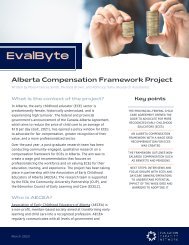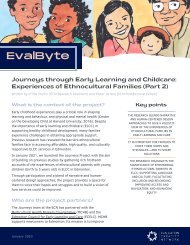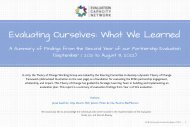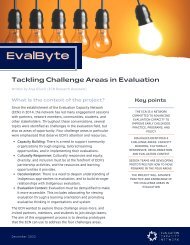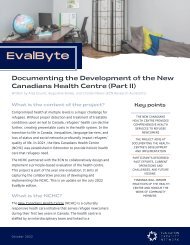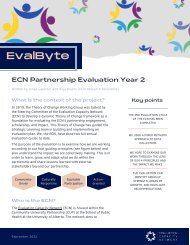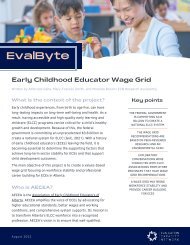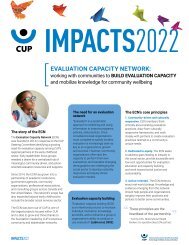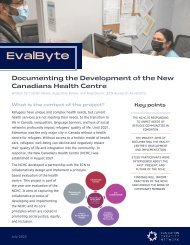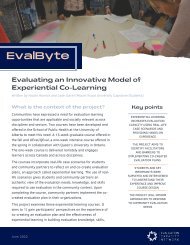Community Report: Research in Action 2015
Create successful ePaper yourself
Turn your PDF publications into a flip-book with our unique Google optimized e-Paper software.
UNIVERSITY WITHIN COMMUNITY:<br />
RESEARCH IN ACTION
A MESSAGE<br />
from the ASSOCIATE DEAN, RESEARCH<br />
Dr. Yoshitaka (Yoshi) Iwasaki
This is a very excit<strong>in</strong>g time for the Faculty of Extension: Our scholars cont<strong>in</strong>ue to be <strong>in</strong>volved<br />
<strong>in</strong> a number of <strong>in</strong>novative, community-based research projects, work<strong>in</strong>g together with their partners from<br />
prov<strong>in</strong>cial and municipal governments, non-profit agencies, Aborig<strong>in</strong>al and immigrant communities, school<br />
boards, health systems, and more.<br />
Extension’s scholars contextualize the research process with<strong>in</strong> the community (rather than on the community)<br />
to generate research outcomes directly relevant and mean<strong>in</strong>gful to the community. Mutually-respectful<br />
relationship build<strong>in</strong>g and collaboration between community and university partners is a hallmark of<br />
Extension’s research.<br />
Our research is always <strong>in</strong> action as we mobilize for positive changes at personal, social, and system levels.<br />
This research builds capacities for people and communities while help<strong>in</strong>g to develop evidence-based<br />
approaches to improv<strong>in</strong>g policy and practice <strong>in</strong> our community.<br />
The mission of the Faculty of Extension is to provide leadership <strong>in</strong> social and <strong>in</strong>dividual betterment through<br />
community-university engagement <strong>in</strong> learn<strong>in</strong>g, discovery, and citizenship. Importantly, action research plays<br />
a significant role <strong>in</strong> all our learn<strong>in</strong>g (from each other), discovery (of new knowledge), and citizenship (to serve<br />
our community), by <strong>in</strong>tegrat<strong>in</strong>g our university with<strong>in</strong> our community.<br />
The theme for this year’s report is “Inspir<strong>in</strong>g Lives.” As shown <strong>in</strong> each of the six stories featured <strong>in</strong> this<br />
report, our scholars’ and partners’ research provides <strong>in</strong>spiration: These stories are about <strong>in</strong>spiration for and<br />
with<strong>in</strong> Métis communities, low-<strong>in</strong>come families, high-risk youth, senior citizens, social service workers, and<br />
First Nations children. Not only do we reveal a fuller, more holistic picture of situations and issues faced by<br />
our communities, but we also build capacities of people and communities to address significant community<br />
issues. This is accomplished by mak<strong>in</strong>g connections, open<strong>in</strong>g space for voices, and mobiliz<strong>in</strong>g research to have<br />
an impact through engag<strong>in</strong>g and build<strong>in</strong>g relationships with our communities.<br />
One major transformation <strong>in</strong> the Faculty of Extension <strong>in</strong>volves the consolidation of Extension’s research units<br />
<strong>in</strong>to the “<strong>Research</strong> Neighbourhood” on the second floor of Enterprise Square. This consolidated space houses<br />
all of Extension’s research centres and units:<br />
• Centre for Public Involvement (CPI)<br />
• City-Region Studies Centre (CRSC)<br />
• <strong>Community</strong>-University Partnerships for the Study of Children, Youth, and Families (CUP)<br />
• Evaluation and <strong>Research</strong> Services (ERS)<br />
• First Nations Children’s <strong>Action</strong> <strong>Research</strong> and Education Services (FNCARES)<br />
Operationally, we have started to implement <strong>Research</strong> Support Services (RSS) to provide Faculty-wide support<br />
for research development, partnership build<strong>in</strong>g, and community engagement through effective management<br />
and susta<strong>in</strong>able support for all stages and levels of Extension’s research <strong>in</strong>itiatives (both new and ongo<strong>in</strong>g).<br />
Based on the pr<strong>in</strong>ciples of collaboration and resource shar<strong>in</strong>g, the RSS with<strong>in</strong> <strong>Research</strong> Neighbourhood is<br />
structured to facilitate greater success for the research enterprise.<br />
Extension’s community-based research is well positioned to significantly contribute to address<strong>in</strong>g major<br />
community issues through partnerships with key stakeholders. Both the Government of Alberta and the City<br />
of Edmonton have declared end<strong>in</strong>g poverty as a top priority, and they eagerly rely on expertise <strong>in</strong> communitybased<br />
research. The announcement of the new Social Innovation Endowment Fund for social sciences and<br />
humanities research by the Government of Alberta is exemplary of the importance of applied action research<br />
to more effectively address major community issues such as poverty, homelessness, early child development,<br />
and Aborig<strong>in</strong>al and immigrant issues.<br />
I am very proud to know that our researchers and research centres <strong>in</strong> the Faculty of Extension are<br />
exceptionally qualified to make a significant contribution to these <strong>in</strong>novative <strong>in</strong>itiatives for the betterment of<br />
our people and communities!<br />
2
THE START OF A<br />
BEAUTIFUL FRIENDSHIP
The people of the Buffalo Lake and Kik<strong>in</strong>o<br />
Métis Settlements are <strong>in</strong>credibly unique<br />
populations with equally unique histories<br />
and cultures. The Faculty of Extension is the<br />
only post-secondary Faculty <strong>in</strong> Canada with<br />
a primary research mandate of community<br />
engagement. The relationship between the<br />
two is anyth<strong>in</strong>g but traditional—but then,<br />
that’s the whole po<strong>in</strong>t.<br />
Fay Fletcher approached the Buffalo Lake<br />
Métis Settlement (BLMS) <strong>in</strong> 2010 to develop<br />
a life-skills program for youth and children to<br />
grow <strong>in</strong> capacity to resist negative behaviour<br />
(e.g., smok<strong>in</strong>g, dr<strong>in</strong>k<strong>in</strong>g, or bully<strong>in</strong>g). At that<br />
time, she had little knowledge of Métis culture.<br />
She did, however, have support from Extension<br />
and Alberta Health Services, which lent a rare<br />
advantage: She could start from scratch.<br />
“We went <strong>in</strong>to this project th<strong>in</strong>k<strong>in</strong>g we should<br />
engage based on our knowledge of First<br />
Nations people,” says Fay. “But we quickly<br />
found that the Métis are very dist<strong>in</strong>ct from<br />
other Aborig<strong>in</strong>al peoples, so we had to build<br />
our own capacity to f<strong>in</strong>d culturally-appropriate<br />
solutions. We had to be very open to ideas and<br />
to engage <strong>in</strong> a lot of dialogue.”<br />
Through these conversations, her research<br />
team found a very strong youth component<br />
<strong>in</strong> the community, so they focused efforts on<br />
a program built and conducted for youth, by<br />
youth. With constant community consultation,<br />
Fay’s team put together the Life Skills Journey<br />
summer day camp, a play-based program<br />
designed to enhance developmental strengths<br />
for seven- to ten-year-olds. BLMS youth were<br />
recruited and tra<strong>in</strong>ed as camp facilitators and<br />
peer mentors.<br />
Fay Fletcher takes engagement<br />
with Albertan Métis communities<br />
to the next level<br />
Fay learned much from the community; six<br />
years ago, for <strong>in</strong>stance, she was strongly<br />
discouraged from us<strong>in</strong>g social media <strong>in</strong> her<br />
community-based research. Experts <strong>in</strong> BLMS,<br />
however, identified those media among the<br />
most effective ways to engage with the youth.<br />
“A member of our research team is very techsavvy,”<br />
says Fay. “She set up a website, a<br />
Facebook profile, and a Twitter account, and<br />
then pushed out messages constantly. We got<br />
permission to use photos from participants,<br />
and we got a lot of friends and followers by<br />
post<strong>in</strong>g those visuals.”<br />
Over summer 2013, day camps were piloted<br />
at Buffalo Lake and Kik<strong>in</strong>o. Fifty-six children<br />
took part <strong>in</strong> ten days of activities, learn<strong>in</strong>g <strong>in</strong><br />
such modules as “anger,” “spirituality,” and<br />
“media messages.” Personal growth among<br />
participants (evaluated us<strong>in</strong>g the validated<br />
Resiliency Framework) was recorded <strong>in</strong><br />
strengths such as acceptance, spirituality,<br />
and reflective th<strong>in</strong>k<strong>in</strong>g, with an overall<br />
reduction <strong>in</strong> at-risk behaviours. The research<br />
team is optimistic to see these trends grow,<br />
particularly if they are able to extend their<br />
current three years of fund<strong>in</strong>g to five. The data<br />
will be enriched further as the team beg<strong>in</strong>s<br />
deliver<strong>in</strong>g the program to 11- through 14-year<br />
olds <strong>in</strong> future years.<br />
More, says Fay, “we can see grow<strong>in</strong>g<br />
connections between the community and the<br />
youth. It’s chang<strong>in</strong>g the whole dynamic!” The<br />
community, <strong>in</strong> turn, has shown an <strong>in</strong>terest <strong>in</strong><br />
the research and a commitment to its success.<br />
“The communities we now work with are as<br />
<strong>in</strong>vested <strong>in</strong> our team’s success and well-be<strong>in</strong>g<br />
as we are <strong>in</strong> theirs,” says Fay. She professes<br />
that the project has developed from one<br />
of engagement <strong>in</strong>to an endur<strong>in</strong>g research<br />
relationship.<br />
“Engagement, I th<strong>in</strong>k, is at its best when it<br />
becomes a relationship; with a relationship<br />
comes accountability to one another. And it’s<br />
encourag<strong>in</strong>g to know that it’s possible for a<br />
university to accomplish this. After all, we<br />
are not dist<strong>in</strong>ct from the community. We are<br />
one and the same. And we are stronger for<br />
realiz<strong>in</strong>g this.”<br />
4
COMMUNICATION:<br />
A SOCIAL LIFE-SAVER
Terrance Saddleback had “a disorder that left<br />
him with the m<strong>in</strong>d and impulse control of a<br />
child” and “suffered from psychotic episodes<br />
accompanied by violent rages,” accord<strong>in</strong>g to<br />
a statement by Valerie Wolski’s husband.<br />
The same statement contends that many<br />
community service organizations knew of<br />
Saddleback’s condition long before he violently<br />
murdered Ms. Wolski <strong>in</strong> 2011.<br />
Breakdowns <strong>in</strong> communication happen all<br />
the time. Sometimes they’re <strong>in</strong>nocuous.<br />
Sometimes, <strong>in</strong> the cases of Ms. Wolski and<br />
other social care service workers, they are<br />
unth<strong>in</strong>kably tragic.<br />
“The notion of social work can conjure up<br />
thoughts of giv<strong>in</strong>g personalities, dedicated<br />
helpers, and families brought together through<br />
car<strong>in</strong>g,” says Extension’s Tom Barker. “As one<br />
social worker put it, the image is all ‘hug-amuff<strong>in</strong>.’<br />
But the reality sometimes means<br />
work<strong>in</strong>g alone <strong>in</strong> rural areas, home visits with<br />
dangerous people, or unit<strong>in</strong>g families where<br />
one partner is under a restra<strong>in</strong><strong>in</strong>g order due to<br />
violent behaviour.”<br />
Accuracy and effectiveness of communication<br />
by front-l<strong>in</strong>e social service workers and the<br />
agencies that represent them is the reason<br />
Tom’s expertise <strong>in</strong> community-based research<br />
and technical communication helped him<br />
co-found the Health and Safety for Child and<br />
Families Services (HSCFS) project.<br />
With a goal to make the lives of these workers<br />
safer by identify<strong>in</strong>g physical, chemical,<br />
biological, environmental, and mental health<br />
hazards, the HSCFS partnership br<strong>in</strong>gs<br />
together representatives from the Faculty of<br />
Extension, the Alberta Association of Services<br />
to Children and Families, and the prov<strong>in</strong>ce’s<br />
M<strong>in</strong>istry of Human Services to galvanize safety<br />
management practices.<br />
Lack of communication can be<br />
fatally dangerous for social<br />
service workers, says Tom Barker<br />
“We’re operat<strong>in</strong>g on a knowledge-to-action<br />
paradigm,” expla<strong>in</strong>s Tom, “and we have a lot<br />
of knowledge available. Once we’ve collected<br />
this data from our partners, we can do a multivariant,<br />
complex analysis of hazards these<br />
workers face and provide useful, actionable<br />
statistics back to those agencies.”<br />
This knowledge, contends Tom, can <strong>in</strong>form<br />
policies on report<strong>in</strong>g of <strong>in</strong>cidents and record<strong>in</strong>g<br />
of data, as well as safety frameworks,<br />
employee tra<strong>in</strong><strong>in</strong>g, and education. “It’s all<br />
communication,” he says, “and it underlies<br />
everyth<strong>in</strong>g <strong>in</strong> the health and safety arena.”<br />
HSCFS is also sett<strong>in</strong>g up a community of<br />
practice for social services workers to speak<br />
with one another over a LISTSERV and to<br />
share stories and <strong>in</strong>formation. Break<strong>in</strong>g down<br />
communication barriers is key, s<strong>in</strong>ce, as Tom<br />
po<strong>in</strong>ts out, “if you want to get <strong>in</strong>formation<br />
from people about safety issues, you can’t just<br />
expect them to respond to a survey. They have<br />
to want to share the <strong>in</strong>formation.”<br />
But how does one communicate best? “We need<br />
buy-<strong>in</strong> from all members of the community,<br />
even just to know which questions to ask,”<br />
says Tom. “A researcher like me would need 20<br />
years of work <strong>in</strong> the field to get the knowledge<br />
you can marshall from professionals with the<br />
expertise to <strong>in</strong>form this research.”<br />
The project began <strong>in</strong> September 2013 and was<br />
<strong>in</strong>tended to last a year; now that pilot studies<br />
have begun <strong>in</strong> Edmonton (and with seven other<br />
sectors <strong>in</strong> Alberta eagerly await<strong>in</strong>g the results),<br />
the project has become ongo<strong>in</strong>g.<br />
“We hope to have data at the end of 2014,<br />
after which we can do a pre- and post-test with<br />
participat<strong>in</strong>g agencies to determ<strong>in</strong>e whether the<br />
knowledge captured leads to an <strong>in</strong>crease <strong>in</strong> the<br />
number of <strong>in</strong>cidents reported,” says Tom.<br />
When a more vivid picture of social service work<br />
is pa<strong>in</strong>ted by this project, however, one wonders<br />
if prospective workers might be scared away<br />
from pursu<strong>in</strong>g this career.<br />
Absolutely not, says Tom.<br />
“The construction <strong>in</strong>dustry, for example, is very<br />
hazardous, but people still enter it. If you know<br />
about the potential hazards <strong>in</strong> your <strong>in</strong>dustry and<br />
how to report when <strong>in</strong>cidents happen, it’s a far<br />
better-managed <strong>in</strong>dustry, and everyone <strong>in</strong> that<br />
<strong>in</strong>dustry is safer than before.”<br />
6
THE KIDS ARE ALL RIGHT
“We work with young people anywhere from 15<br />
to 24 years old. And they’re very disengaged.<br />
Many used to be homeless and have no parental<br />
support. Some have spent time <strong>in</strong> prison.<br />
They’re often disconnected from ma<strong>in</strong>stream<br />
Canadian society. So researchers call them<br />
marg<strong>in</strong>alized, or at-risk, or high-risk youth, but<br />
the youth themselves don’t like any of those<br />
terms.”<br />
What do they prefer?<br />
“People.”<br />
Yoshi Iwasaki delivers that last word with a<br />
smirk. “We are all people,” he expla<strong>in</strong>s, “And we<br />
all deserve to be engaged with our communities<br />
and provided with mean<strong>in</strong>gful opportunities.”<br />
Yoshi was just beg<strong>in</strong>n<strong>in</strong>g his new job at<br />
Extension (then as Director of Extension’s<br />
<strong>Community</strong>-University Partnership for the<br />
Study of Children, Youth, and Families) when<br />
he got <strong>in</strong>volved <strong>in</strong> discussions among local<br />
agencies support<strong>in</strong>g youth development; these<br />
organizations lacked a coord<strong>in</strong>ated context with<br />
which to engage those youth. Most, says Yoshi,<br />
operate on a “talk-down” basis, without fully<br />
<strong>in</strong>tegrat<strong>in</strong>g the voice of youth.<br />
“Have we tried listen<strong>in</strong>g to them?”<br />
Yoshi Iwasaki posits<br />
about disengaged youth<br />
“We put together a team to talk about what a<br />
framework might look like, and look<strong>in</strong>g around<br />
the table, the first th<strong>in</strong>g I asked was ‘Okay,<br />
where are the youth?’”<br />
A valid po<strong>in</strong>t. Yoshi’s experience <strong>in</strong> engag<strong>in</strong>g<br />
and mobiliz<strong>in</strong>g marg<strong>in</strong>alized population groups<br />
<strong>in</strong>formed an op<strong>in</strong>ion that this framework (and<br />
the research needed for the new Youth4YEG<br />
<strong>in</strong>itiative to build it) had to be youth-driven (“we<br />
work with youth, not on youth,” Yoshi stresses).<br />
“We needed to create a home-grown framework<br />
for youth engagement, basically from scratch,”<br />
says Yoshi. Youth4YEG was able to recruit a<br />
number of marg<strong>in</strong>alized youth leaders who<br />
were recommended by partner agencies to<br />
attend a series of weekday even<strong>in</strong>g discussions<br />
to exchange stories and to identify pr<strong>in</strong>ciples<br />
and processes that would make up a youth<br />
engagement framework.<br />
Says Yoshi: “We get a dozen or so young people<br />
<strong>in</strong>to the room, we lay down some ground rules,<br />
then we order pizza and do activities like talk<strong>in</strong>g<br />
circles.”<br />
Other agencies, he po<strong>in</strong>ts out, do similar<br />
activities, but do not systematically collect data.<br />
“We have partnerships with the city<br />
government and the prov<strong>in</strong>cial government, as<br />
well as Edmonton’s youth agencies, and they’re<br />
very excited about what we’re do<strong>in</strong>g, s<strong>in</strong>ce<br />
they haven’t until now had access to research<br />
expertise and resources,” says Yoshi.<br />
The Youth4YEG team has, at the time of<br />
writ<strong>in</strong>g, conducted four three-hour youth<br />
engagement sessions s<strong>in</strong>ce they began <strong>in</strong><br />
October 2012; each time, researchers ask very<br />
strategic questions, such as “tell us one positive<br />
th<strong>in</strong>g that’s happened to you” or “what are<br />
the most important th<strong>in</strong>gs for gett<strong>in</strong>g you<br />
engaged?”<br />
The youth leaders (as co-<strong>in</strong>vestigators) have<br />
already developed an 13-page framework that<br />
is be<strong>in</strong>g tested us<strong>in</strong>g <strong>in</strong>ductive research and<br />
constant feedback. Once test<strong>in</strong>g is complete,<br />
Yoshi is confident that this youth-created<br />
framework (the first of its k<strong>in</strong>d) will be effective<br />
<strong>in</strong> positively engag<strong>in</strong>g youth locally, nationally,<br />
and <strong>in</strong>ternationally.<br />
“The framework is home-grown but can be<br />
applied cross-culturally when you <strong>in</strong>corporate<br />
local and cultural uniqueness to make it<br />
effective <strong>in</strong> an action plan,” says Yoshi. “It is<br />
a template, not a prescription. It’s important<br />
that every agency develop its own plan<br />
when empower<strong>in</strong>g youth. And engagement<br />
is essential for every youth, regardless of<br />
nationality or cultural background.”<br />
So how does a young person know if he or she<br />
is “engaged?”<br />
Says Yoshi: “They seem to understand<br />
<strong>in</strong>tr<strong>in</strong>sically which activities are good and which<br />
are bad. They know, for example, that drug<br />
abuse and violence are bad. So engagement,<br />
for them, means participat<strong>in</strong>g <strong>in</strong> activities they<br />
consider ‘good’ and constructive, and if they<br />
choose to do those ‘positive’ th<strong>in</strong>gs on their<br />
own terms, they’re much more likely to become<br />
healthy, contribut<strong>in</strong>g members of society.<br />
Relationship-build<strong>in</strong>g with youth through youth<br />
leadership is very important to this process.”<br />
8
THE GOLDEN CENTRE
“They’re places for someone like Ernie,” says<br />
Kyle Whitfield. “He’s 82. Everyday s<strong>in</strong>ce his wife<br />
died, he walks to the centre for breakfast and a<br />
chat with friends. Then, he says, he can carry on<br />
with his day.”<br />
Over the past year, Kyle’s conversations with<br />
patrons of seniors’ centres <strong>in</strong> Alberta have<br />
unearthed a trove of similar tales of reduced<br />
mobility, social isolation, and grief over the loss<br />
of loved ones, and, as her research partner Jason<br />
Daniels says, “seniors’ centres are the reason a<br />
lot of people get out of bed <strong>in</strong> the morn<strong>in</strong>g.”<br />
S<strong>in</strong>ce spr<strong>in</strong>g<strong>in</strong>g up sporadically <strong>in</strong> the 1970s,<br />
such centres have provided services, activities,<br />
and places for conversation, and they have<br />
become so successful that the Alberta<br />
Association of Seniors’ Centres (AASC) now lists<br />
over 400 centres <strong>in</strong> their 2014 directory.<br />
It’s difficult to th<strong>in</strong>k of a more ideal system:<br />
the centres are self-susta<strong>in</strong><strong>in</strong>g, typically<br />
adm<strong>in</strong>istered by their members, and, accord<strong>in</strong>g<br />
to Roger La<strong>in</strong>g, president of AASC, “vital to the<br />
lives of seniors throughout Alberta.”<br />
Why, then, did Health M<strong>in</strong>ister Fred Horne<br />
announce <strong>in</strong> January 2013 that the prov<strong>in</strong>cial<br />
government would grant $70,800 for research<br />
<strong>in</strong>to the current state of our seniors’ centres?<br />
The question encompasses so many factors<br />
and nuances it could hardly be answered over<br />
afternoon tea or a game of cards.<br />
Currently, history’s most-populous generation is<br />
enter<strong>in</strong>g its autumn years, and seniors’ centres<br />
do not have the capacity to handle them.<br />
That’s assum<strong>in</strong>g, of course, the Boomers will<br />
choose to jo<strong>in</strong> these centres.<br />
Extension duo tasked with<br />
pa<strong>in</strong>t<strong>in</strong>g a complex portrait of<br />
Albertan Seniors’ Centres<br />
Complicat<strong>in</strong>g th<strong>in</strong>gs, says Jason (a member of<br />
Extension’s Evaluation and <strong>Research</strong> Services<br />
and the project’s “numbers guy”), is <strong>in</strong>creas<strong>in</strong>g<br />
diversity <strong>in</strong> clientele populations, which makes it<br />
difficult to ensure everyone’s needs are met.<br />
For that matter, the def<strong>in</strong>ition of seniors’<br />
centres is as elusive as that of a senior (says<br />
Kyle, they’re terms like “teenager” that assume<br />
a 13-year-old is the same as a 19-year-old).<br />
Urban centres differ from rural centres;<br />
governance structures differ from town to town.<br />
And because services differ so greatly,<br />
it’s hard to say exactly what constitutes a<br />
seniors’ centre.<br />
The freeform nature of the centres spells<br />
uncerta<strong>in</strong>ty <strong>in</strong> the com<strong>in</strong>g twilight of the<br />
Boomers, and Roger La<strong>in</strong>g knows it. It was<br />
his idea to approach Kyle, whose previous<br />
research <strong>in</strong>to Alberta’s ag<strong>in</strong>g populations begat<br />
a strong work<strong>in</strong>g relationship with AASC.<br />
Their conversation led to a research proposal,<br />
which, when presented to the M<strong>in</strong>istry of<br />
Health, germ<strong>in</strong>ated this study with Kyle as lead<br />
researcher and Jason as research designer.<br />
“It’s a complex issue, so we chose a mixedmethod<br />
approach,” Jason expla<strong>in</strong>s. “We<br />
surveyed seniors and soon-to-be-seniors about<br />
the centres. We surveyed the directors to f<strong>in</strong>d<br />
out what services they provided and what their<br />
needs are. And we did site visits and focus<br />
groups at eight different centres,” (where, says<br />
Kyle, Jason suspiciously showed up just <strong>in</strong> time<br />
for c<strong>in</strong>namon buns).<br />
At the time of writ<strong>in</strong>g, the data has been<br />
collected. Jason is mak<strong>in</strong>g graphs and tables and<br />
Kyle is f<strong>in</strong>ish<strong>in</strong>g up a literature review. Both are<br />
noticeably engrossed <strong>in</strong> the process.<br />
“My naïve understand<strong>in</strong>g of seniors’ centres at<br />
the outset has broadened considerably,” says<br />
Jason. “I saw them orig<strong>in</strong>ally as drop-<strong>in</strong> social<br />
centres, but they’re also places of learn<strong>in</strong>g<br />
and volunteer<strong>in</strong>g and help<strong>in</strong>g one another. The<br />
wealth of expertise <strong>in</strong> every person we spoke<br />
with was <strong>in</strong>credible.”<br />
Says Kyle: “There’s a lot of laughter and<br />
socializ<strong>in</strong>g [at the centres]. And there’s plenty<br />
of evidence that people who laugh and have<br />
more personal connections have better overall<br />
health. If we expect to engage with seniors<br />
and to benefit from their knowledge and<br />
contributions, we need a more complete picture<br />
of their needs. Which is what we’re about to<br />
accomplish.”<br />
10
LIKE KIDS IN A DATA STORE
Every research project is an <strong>in</strong>vestment. Very<br />
few, however, have this many <strong>in</strong>vestors.<br />
S<strong>in</strong>ce 2006, at the beg<strong>in</strong>n<strong>in</strong>g of a multi-year<br />
longitud<strong>in</strong>al study of low-<strong>in</strong>come families <strong>in</strong><br />
Edmonton, the number of stakeholders <strong>in</strong> the<br />
Fulfill<strong>in</strong>g Alberta’s Commitment (FACt) project<br />
has grown to <strong>in</strong>clude governments, NGOs,<br />
funders, academics, students, and the research<br />
participants themselves. Thousands of hours<br />
and millions of dollars will soon result <strong>in</strong> actions<br />
to improve these families’ lives.<br />
“At least we hope so,” says Maria Mayan.<br />
A found<strong>in</strong>g member of Families First Edmonton<br />
(FFE), now <strong>in</strong> its twelfth year, Maria (along with<br />
her colleague Laurie Schnirer) is oversee<strong>in</strong>g<br />
what grew from a group of concerned citizens<br />
<strong>in</strong>to a sprawl<strong>in</strong>g, ambitious research project<br />
with a “blow-your-m<strong>in</strong>d” database compris<strong>in</strong>g<br />
six years of periodic <strong>in</strong>terviews with low-<strong>in</strong>come<br />
families. It’s a fantasy come true for any applied<br />
research protagonist. But time is of the essence.<br />
“We’re currently work<strong>in</strong>g on <strong>in</strong>terpret<strong>in</strong>g the<br />
data,” says Maria. “Our partner agencies f<strong>in</strong>d<br />
mean<strong>in</strong>g and context <strong>in</strong> our results, and we take<br />
our directional cues from them.”<br />
The next step, she says, is to offer to Alberta<br />
Human Services evidence of how some low<strong>in</strong>come<br />
families eventually achieve economic<br />
self-sufficiency. Or of what impact child care<br />
subsidies have on families’ economic outcomes.<br />
Or of what happens to families who move<br />
residences frequently. All are vital questions<br />
that h<strong>in</strong>ge on future fund<strong>in</strong>g.<br />
Salvation for everyone’s <strong>in</strong>vestment, it seems,<br />
may be <strong>in</strong> the hands of community-m<strong>in</strong>ded<br />
graduate students, recruited and coord<strong>in</strong>ated by<br />
FACt’s Knowledge Broker, Nyla de Los Santos.<br />
“We put a blurb about the project on a grad<br />
student LISTSERV,” says Nyla, “and immediately<br />
started gett<strong>in</strong>g a lot of applications.<br />
Hope for low-<strong>in</strong>come families is <strong>in</strong><br />
the FACt grad student bra<strong>in</strong>-bank<br />
But we could only accommodate ten students.<br />
I’m very satisfied that we’ve chosen well.”<br />
The students, says Nyla, br<strong>in</strong>g diverse<br />
backgrounds <strong>in</strong> their <strong>in</strong>terests and <strong>in</strong> their<br />
personal stakes <strong>in</strong> the research.<br />
“These people are potentially go<strong>in</strong>g to do this<br />
sort of work <strong>in</strong> their chosen field. Here, they<br />
get hands-on experience <strong>in</strong> community-based<br />
research, a complete data set cover<strong>in</strong>g many<br />
areas of <strong>in</strong>terest and discipl<strong>in</strong>e, and a chance to<br />
see their work affect real people,” she says.<br />
The students agree.<br />
“FACt is hav<strong>in</strong>g a larger impact than I’d<br />
imag<strong>in</strong>ed,” says Katie MacDonald, a doctoral<br />
student <strong>in</strong> Sociology. “I see the project<br />
embrac<strong>in</strong>g the complexity of experiences and<br />
struggles that families liv<strong>in</strong>g on low <strong>in</strong>comes<br />
face.”<br />
The work stimulates some of her teammates<br />
on a more personal level: “I’ve learned<br />
about the struggles my parents may have<br />
gone through years ago as first generation<br />
Canadian immigrants,” says Sonya Sehgal,<br />
Masters’ student <strong>in</strong> Educational Psychology.<br />
“I want to give back by help<strong>in</strong>g out immigrant<br />
communities through my work.”<br />
More than this, the students are mak<strong>in</strong>g<br />
personal connections with other stakeholders;<br />
Nyla and Maria frequently ask them to attend<br />
and present at meet<strong>in</strong>gs of the entire FACt<br />
team, <strong>in</strong>clud<strong>in</strong>g community members external<br />
to the University.<br />
“I’m learn<strong>in</strong>g that a lot of people genu<strong>in</strong>ely care<br />
about reduc<strong>in</strong>g <strong>in</strong>come disparity,” says Lesley<br />
Pullishy, who is us<strong>in</strong>g FACt data for her Masters’<br />
thesis <strong>in</strong> Nurs<strong>in</strong>g. “After work<strong>in</strong>g with others on<br />
FACt, I feel <strong>in</strong>spired by the good work go<strong>in</strong>g on<br />
locally.”<br />
Is it worth all the effort? Yes, says Maria (albeit<br />
hesitantly).<br />
“I don’t th<strong>in</strong>k we have accomplished what we<br />
set out to do,” she says. “We can fill up five<br />
years answer<strong>in</strong>g important questions with this<br />
data set. We said years ago ‘if our partnership<br />
of people, after 12 years, with all this expertise,<br />
after everyth<strong>in</strong>g we’ve been through, CAN’T<br />
change policy or practice, we might as well....”<br />
She doesn’t f<strong>in</strong>ish the sentence.<br />
12
RESEARCH IN ACTION
The <strong>in</strong>terview that <strong>in</strong>formed this feature<br />
took place <strong>in</strong> a Starbucks near Extension’s<br />
headquarters, ma<strong>in</strong>ly because C<strong>in</strong>dy Blackstock,<br />
Director of the First Nations Children’s <strong>Action</strong><br />
<strong>Research</strong> and Education Service (FNCARES)<br />
doesn’t have an office <strong>in</strong> Edmonton, and<br />
appropriately so: She believes community-based<br />
work means that her office needs to be <strong>in</strong> the<br />
community, where people naturally gather.<br />
C<strong>in</strong>dy is forever <strong>in</strong> motion, and she’s currently<br />
testify<strong>in</strong>g to the Canadian Human Rights<br />
Tribunal, call<strong>in</strong>g the federal government to task<br />
over <strong>in</strong>equitable conditions for Canada’s First<br />
Nations children and youth. She’s <strong>in</strong> Edmonton<br />
today to take part <strong>in</strong> a panel discussion<br />
alongside director Alanis Obomsaw<strong>in</strong>, whose<br />
film “Hi Ho Mistahey!” will be screened for the<br />
first time <strong>in</strong> Alberta.<br />
The film documents the life of Shannen<br />
Koostach<strong>in</strong>, a young woman from the<br />
Attawapiskat First Nation of Ontario, whose<br />
activism for First Nations education is<br />
emblematic of the action-oriented philosophy<br />
at the core of FNCARES.<br />
Shannen was educated <strong>in</strong> portable trailers that<br />
stood <strong>in</strong> for her condemned school. The shoddy<br />
conditions were not atypical to First Nations<br />
schools, which even today deal with pest<br />
<strong>in</strong>festations, lack of heat<strong>in</strong>g or plumb<strong>in</strong>g, and<br />
no libraries or computer labs. Shannen wrote<br />
letters to politicians and encouraged others<br />
to do so. She spoke at events and stood on<br />
Parliament Hill to testify to the lack of fund<strong>in</strong>g<br />
for these schools—all this before she died <strong>in</strong> a<br />
traffic accident hundreds of miles from home,<br />
where she travelled to attend a proper<br />
high school.<br />
“This is an urgent <strong>in</strong>equality,” expla<strong>in</strong>s C<strong>in</strong>dy.<br />
“Children only get one childhood, and they’re<br />
grow<strong>in</strong>g up right now. This urgency hasn’t<br />
gripped our politicians, so I’ve had to move<br />
beyond academics to evidence-based activism.<br />
FNCARES debuts as a different k<strong>in</strong>d<br />
of research centre to make positive<br />
change for First Nations children<br />
When governments fail to address significant<br />
public policy issues despite evidence of the<br />
harm and available solutions, then it is the<br />
responsibility of the academic community to<br />
work with those affected to advance positive<br />
change.”<br />
Many of the challenges fac<strong>in</strong>g First Nations<br />
children could be addressed with evidencebased<br />
solutions, says C<strong>in</strong>dy. She offers an<br />
example:<br />
“In the United States, the federal government<br />
found that 30 per cent of children went <strong>in</strong>to<br />
foster care because of hous<strong>in</strong>g <strong>in</strong>stability.<br />
The government provided $15 million to social<br />
workers to spend up to a value of $14,000 per<br />
family. So those workers might have chosen<br />
to pay a family’s first and last month’s rent,<br />
renovated the bathroom for a child with a<br />
disability, or got rid of a mold contam<strong>in</strong>ation.<br />
That <strong>in</strong>vestment saved 7500 kids from go<strong>in</strong>g<br />
<strong>in</strong>to foster care and saved $131 million <strong>in</strong> taxes<br />
<strong>in</strong> the process. These are the sorts of practical<br />
solutions we should search for.”<br />
To mobilize <strong>in</strong>formation, FNCARES will access<br />
a multi-discipl<strong>in</strong>ary network of 21 lead<strong>in</strong>g<br />
researchers from across Canada, the US, and<br />
Australia.<br />
Says C<strong>in</strong>dy: “I’ve been blessed to work with<br />
fantastic researchers, and I am will<strong>in</strong>g to raise<br />
the ‘help’ flag quickly. I am fortunate to have a<br />
circle of traditional knowledge holders, as well<br />
as gifted academics across discipl<strong>in</strong>es who can<br />
guide our work for children and families.”<br />
The first meet<strong>in</strong>g of FNCARES researchers<br />
will take place <strong>in</strong> 2014, after the case aga<strong>in</strong>st<br />
the federal government concludes. C<strong>in</strong>dy is<br />
optimistic this will provide momentum to spur<br />
conversation and action among partners.<br />
“There’s an Elder’s teach<strong>in</strong>g that says ‘a lot of<br />
people know the road and few people walk it.’<br />
<strong>Action</strong> research is about walk<strong>in</strong>g the road,” says<br />
C<strong>in</strong>dy. “I see research as be<strong>in</strong>g <strong>in</strong> service of the<br />
community. And if you see it that way, you have<br />
to be part of the change process. You ARE the<br />
change process.”<br />
14
FACULty of Extension<br />
2013-2014:<br />
PROFESSORIATE:<br />
Marco Adria, PhD<br />
Professor<br />
Academic Director, Centre for Public<br />
Involvement<br />
Walter Archer, PhD<br />
Professor Emeritus<br />
Academic Director, Teach<strong>in</strong>g and Learn<strong>in</strong>g<br />
Thomas Barker, PhD<br />
Professor<br />
Mary Beckie, PhD<br />
Associate Professor<br />
C<strong>in</strong>dy Blackstock, PhD<br />
Associate Professor<br />
Executive Director, First Nations Child and<br />
Family Car<strong>in</strong>g Society<br />
Katy Campbell, PhD<br />
Professor<br />
Dean, Faculty of Extension<br />
Sherry Ann Chapman, PhD<br />
Assistant Professor<br />
Ann Curry, PhD<br />
Professor<br />
Fay Fletcher, PhD<br />
Associate Professor<br />
Academic Director, Aborig<strong>in</strong>al Health Promotion<br />
Citation, <strong>Community</strong> Engagement Studies<br />
Lois Gander, Q.C., LL. M.<br />
Professor<br />
Rebecca Gokiert, PhD<br />
Assistant Professor<br />
Gordon Gow, PhD<br />
Associate Professor<br />
Academic Director, Communications &<br />
Technology Graduate Program<br />
Mart<strong>in</strong> Guardado, PhD<br />
Associate Professor<br />
Academic Director, English Language Program<br />
Yoshitaka (Yoshi) Iwasaki, PhD<br />
Professor<br />
Associate Dean, <strong>Research</strong><br />
Maria Mayan, PhD<br />
Associate Professor<br />
Laurie Schnirer, PhD<br />
Assistant Professor<br />
Interim Director, <strong>Community</strong>-University<br />
Partnership for the Study of Children, Youth,<br />
and Families (CUP)<br />
Rob Shields, PhD<br />
Professor<br />
Henry Marshall Tory <strong>Research</strong> Chair<br />
Academic Director, City-Region Studies Centre<br />
Billy Strean, PhD<br />
Professor<br />
Kristof Van Assche, PhD<br />
Associate Professor<br />
Stanley Varnhagen, PhD<br />
Faculty Service Officer IV<br />
Academic Director, Evaluation and <strong>Research</strong><br />
Services<br />
Kyle Whitfield, PhD<br />
Associate Professor
ADJUNCT PROFESSORS:<br />
Jeff Bisanz, PhD<br />
Chair, Psychology, University of Alberta<br />
<strong>Community</strong>-University Partnership for the<br />
Study of Children, Youth, and Families<br />
Mart<strong>in</strong> Garber-Conrad, CEO<br />
Edmonton <strong>Community</strong> Foundation<br />
<strong>Community</strong>-University Partnership for the<br />
Study of Children, Youth, and Families<br />
Monica Gruezmacher Rosas, PhD<br />
Environmental Resource Management Program<br />
Susan Lynch, PhD<br />
<strong>Research</strong> Project Director<br />
Early Child Development Mapp<strong>in</strong>g Project<br />
<strong>Community</strong>-University Partnership for the<br />
Study of Children, Youth, and Families<br />
Helen Madill, PhD<br />
Professor Emerita<br />
Office of the Dean<br />
Patricia Makokis, PhD<br />
<strong>Community</strong> Engagement Studies<br />
Debra Pozega Osburn, PhD<br />
Vice President, University Relations<br />
University of Alberta<br />
Communications & Technology<br />
Graduate Program<br />
Jorge Sousa, PhD<br />
Associate Professor, Educational Policy Studies<br />
University of Alberta<br />
Jane Spr<strong>in</strong>gett, PhD<br />
Director, Centre for Health Promotions Studies<br />
School of Public Health, University of Alberta<br />
<strong>Community</strong>-University Partnership for the<br />
Study of Children, Youth, and Families<br />
Mark Wolfe, PhD<br />
Communications and Technology<br />
Graduate Program<br />
STATISTICS:<br />
2012-2013 2013-2014*<br />
Year-Over-Year<br />
Comparison<br />
<strong>Research</strong> Grants $1,270,783 $1,526,617 20%<br />
Professoriate 19 20 5%<br />
Program Areas Offered<br />
(credentials, designations, etc)<br />
42 46 10%<br />
Courses Offered 327 300 -8%<br />
Course Sections Offered 851 863 1%<br />
Individual Learners 7,627 7,518 -1%<br />
International Students 1,099 1,262 15%<br />
*Please note: this data represents the time period April 1, 2013 to March 18, 2014 (i.e. not the full fiscal year)<br />
16
Vision:<br />
To be an exemplary centre for the scholarship and practice<br />
of community-university engagement.<br />
Mission:<br />
To provide leadership for social and <strong>in</strong>dividual betterment<br />
through community–university collaborations <strong>in</strong> learn<strong>in</strong>g,<br />
discovery and citizenship.<br />
Values:<br />
The Faculty of Extension’s values encompass academic rigor,<br />
accessibility, accountability, collaboration, cooperation,<br />
equity, excellence, relevance, respect, responsiveness,<br />
environmental susta<strong>in</strong>ability, and social justice.
The 15th Annual<br />
Engagement Scholarship Consortium<br />
Conference<br />
Engag<strong>in</strong>g for Change:<br />
Chang<strong>in</strong>g for Engagement<br />
hosted by the<br />
University of Alberta<br />
<strong>in</strong> Edmonton, Alberta, Canada<br />
October 5 - 8, 2014<br />
www.escc2014.com<br />
The University of Alberta <strong>in</strong>vites engaged scholars throughout the world<br />
to the 15th annual Engagement Scholarship Consortium Conference, to<br />
be held <strong>in</strong> Edmonton, Canada with pre-conference days on<br />
October 5 & 6 and full conference on October 7 & 8.<br />
Our conference theme is Engag<strong>in</strong>g for Change: Chang<strong>in</strong>g for<br />
Engagement and will challenge scholars, students, and community<br />
partners to discuss <strong>in</strong>ternational advances <strong>in</strong> the scholarship of<br />
engagement.<br />
engagementscholarship.org/conference
“INSPIRING LIVES”<br />
UNIVERSITY OF ALBERTA<br />
FACULTY OF EXTENSION<br />
Enterprise Square<br />
10230 Jasper Avenue<br />
Edmonton, AB T5J 4P6<br />
2008130




